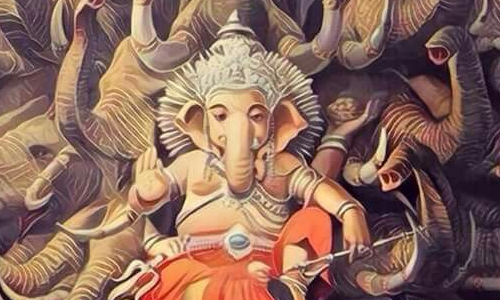Bhagavan Ganesha is one of the most well-known and venerated representations of God, worshipped for thousands of years. He is considered the master of intellect and wisdom. The history of worshipping this form of the Divine, the Lord of beginnings, has been documented in ancient Hindu scriptures. The Rig and Yajur Veda begin with an invocation to Ganeshji. There are also many references to Him in the great epics of Raamaayana, Mahabhaarat and the Puraanas, all of which indicate that the worship of Bhagavan Ganesh has been one of the many ancient customs of Hinduism that have stood the test of time, and up to today, continues to hold increasing appeal among devotees.
The Shri Ganapati Atharvasheersha reveals the nature of this deity as containing all Divine forms within Himself, the embodiment of the ultimate Brahman. In this stotra, Ganeshji is said to be the creator, sustainer and destroyer of the universe. He is the manifestation of the three planes of existence: Bhu (earth), Bhuvah (intermediate sphere) and Svah (heavens). The expression, ‘Idam Sarvam’ –‘You alone are all this’ sums it up. Bhagavan Ganesh is the all-pervading reality.
To His devotees, Bhagavan Ganesh is that aspect of God that removes all difficulty, overcomes all challenges and brings success and fulfillment in all undertakings. The worship of Bhagavan Ganesh yields vivek, the power to discriminate between the real and the unreal. Through him, devotees begin the journey towards worldly success, spiritual advancement and union with the Supreme. No auspicious activity can be undertaken without invoking His name. He is the first of the Panch-devta, the five prime Hindu deities; He is worshipped before all of them. New beginnings are synonymous with the name of Bhagavan Ganesh and most religious activities are initiated with chants of ‘Om Shri Ganeshaaya Namah’.
His physical manifestation has deep philosophical significance, which can guide one to reach that ultimate state of moksha or liberation. Bhagavan Ganesh is a manifested form of the Divine. The human body of Lord Ganesh, which represents the manifest principle, is subordinate to the unmanifest principle represented as the elephant’s head. It is this combination of opposites, the co-existence of the human body and the elephant (manifest and unmanifest) that illustrates the concept of non-duality. This form of Divinity reminds us that we should strive to attain that state where we perceive a state of unity amidst this world of diversity. This state of non-duality between man and the Supreme Being is expressed in the Mahaavaakyas of the Vedas, as ‘Tat Twam Asi ’- ‘Thou Art That’.
The elephant’s head also symbolizes the outer, macroscosmic world while the human body signifies the microcosmic or inner world. Together, they represent the merging of the microcosm with the macrocosm to form one whole. It is a perfect manifestation of the highest truth, ‘Aham Brahman Asmi’, ‘I am Brahman.’
The elephant’s curved trunk represents the intellectual potential that manifests in the power of discrimination between the real and unreal (vivek). Man’s intellect is of two kinds, gross and subtle. The gross intellect is used to discriminate between pairs of opposites in the world such as black and white, hard and soft, easy and difficult. The subtle intellect, on the other hand, discriminates between right and wrong; permanent and impermanent and is often called the conscience. In a person who has attained a higher state of enlightenment, both the gross and subtle intellect is well-developed. Even devotees who have made some progress on the spiritual path experience this. Without clarity of thought, one’s world view is confused and coloured by one’s own prejudices and preconceptions. Bhagavan Ganesh’s form symbolises a crystal clear intellect that leads to a state of perfection.
The single tusk indicates that this journey of life should be one where we acquire the ability to overcome all forms of duality, and ultimately experience the entire world as a state of non-duality. Two tusks represent the pairs of opposites that exist in the world. As Ganesh Bhagavan has one of His tusks broken, it symbolizes that He is dwanda-ateetha, beyond opposites. It teaches us that there is need to transcend the limitations of opposites in order to master the world.
The wide ears of the Lord denote wisdom and the ability to listen and reflect upon spiritual truths. Ears are used to gain knowledge and His large ears indicate that when God is known, all knowledge is known.
His huge belly signifies the ability of the perfect human to consume and digest whatever experiences he undergoes, however auspicious or inauspicious they may be. Additionally, the huge belly is a symbol of material prosperity, power and progress. When an individual subscribes to the principles of positive virtues, of self-restraint and other such tenets of Sanatan Dharma, one achieves all material gains while at the same time maintaining an attitude of indifference towards them.
He has one folded leg while the other rests on the ground. The leg on the ground indicates that one should attend to worldly needs but should not allow life to be consumed by them. While fulfilling the daily demands, one should remain deeply-rooted in single-pointed concentration upon the Supreme Reality, as represented by the folded leg.
The mouse is the vehicle of the Lord and it symbolises the power of desire that exists within each individual. Such is the nature of the ego that it sweeps away everything in its path in order to fulfil desires. As the vehicle of Ganeshji, the mouse teaches humans that he should allow himself to be guided by God in order to overcome egoistic inclinations.
As Hindus observe Ganesh Jayanti followed by the auspicious period of Shri Ganesh Utsov from September 12 – 23, 2018, may it provide us all with the opportunity to develop our discriminative power to advance in our spiritual quest.



